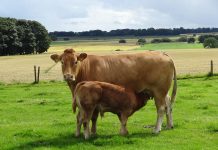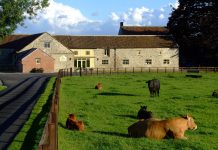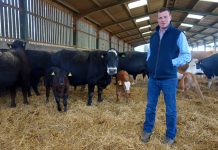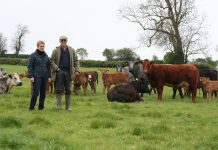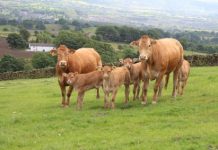Feature on the Stockdale family’s commercial suckler herd at Oat Croft Farm, Burnsall, near Skipton in North Yorkshire.

Brothers, Jim and Richard and Richard’s son, Dan all work on the family beef and sheep farm, with Jim mainly taking care of the 70-cow suckler herd. It is focused on store cattle production, although some animals may be taken through to finishing, depending on circumstances.
The Stockdales were dairy farmers until the late 1990s and a Limousin bull had always been used to produce heifers, many of which were sold at Carlisle Auction Mart with their calves at foot. When the family went out of milk, the Limousin remained and it has continued to play a key role in the farm’s breeding policy.
Sadly, the majority of livestock were culled during the foot-and-mouth crisis in 2001 and the farm was re-stocked with British Limousin and British Blue crosses out of the dairy herd. Since then, only the best females have been selected as replacements and numbers are made up by the purchase of about a dozen, similarly cross-bred heifers each year. The Limousin is used exclusively within the stock bull team and the females calve from January until May, with all of their progeny sold through the local auction mart at Skipton.
There will be a few surplus heifers for 2016 and these will also be offered at Skipton, with their calves alongside them. Jim likes to calve heifers at about three years old, as he believes that calving too early will restrict their growth. He has a clear picture of the type he is seeking in his female lines.
“Milkiness is a key attribute for breeding females and they must also be durable; our average cow will produce eight calves and some will go on to have two or three more,” says Jim.
“Cull cow prices have not been too bad and I like to put a bit of flesh on them, before they are sold. A cow which had slipped her calf went for £990 in January and another made more than £1,000, after being fed on silage for a couple of months.”
Three Limousin stock bulls are required to service the three separate blocks of land that make up the farm. These include Homebyres Geordie, a Homebyres Vanhee son out of Homebyres Elki. He was purchased from Messrs J Logan of Kelso for 6,000gns at the February 2013 BLCS Show and Sale in Carlisle. The Homebyres bull was the farm’s most expensive purchase to date. However, he has proved to be well worth the investment, as he has produced some excellent calves.
The second stock bull is Fieldson Hussar, a Sarkley Cossack son which was purchased privately in 2014. Jim had heard good reports of the Fieldson cattle and felt their reputation was justified, when he visited the farm. The final member of the bull trio is an unregistered, home-bred Limousin by John and Claire Mason’s Oddacres Bullseye.

“High growth rates and plenty of shape are my priorities,” stresses Jim. “A bull that will suit our type of land should not be too big, although I like to see muscularity and good width. EBVs are given consideration and from my perspective, calving ease is paramount and I need low birth weights. I also pay close attention to 400-day weight figures, because that is where the buyers’ main interest lies. Our cattle have to show they have the potential to turn into a top-notch finished animal, as that is the quality that our customers demand. More recently, I have become aware that figures for pelvic measurement can be significant and that is something that I will be looking at in the future.”
Jim comments that in his opinion, some bulls presented at sales are carrying too much flesh.
“I quite understand why vendors of bulls want them to look their best before putting them up for sale, but my animals operate in a fairly harsh environment and they are expected to work hard. So I would rather see them in a more natural state and that is the reason why I sometimes buy privately. Despite that, I think that the pedigree breeders have succeeded in their efforts to improve both shape and temperament.”
AI was used on the dairy cows, but has not yet been applied to the suckler herd.
“Fertility has not been an issue and our bulls generally operate very efficiently. I would like to have the option of speeding up genetic progress through AI, but the farm’s location does not make it easy. The number of dairy farms in this area has declined rapidly over the past few years and the AI man has to make a special trip to get here. By the time he arrives, a cow can sometimes have gone off heat.”
Winters are long and usually last from October until May, with some of the cows and calves over-wintered in the old dairy cubicles and others in straw-bedded accommodation. All of the females are kept on straw until they calve down and fed a ration comprising clamp silage, straw and minerals, throughout the housing period.
To reduce stress, April and May-born calves stay on their mothers at housing. They are offered creep feed and weaned in late January and early February. In the summer, the system relies on grazing the cows and calves grazing alongside the ewes and lambs, so is impractical to make creep feed available until August, when the lambs are weaned. By this time, the early-calved cows will have been split between those with bull calves and those with heifers. Only the bull calves receive creep feed and it is always used sparingly, to keep costs down.
Due to the many footpaths which run through the farm, cows and calves can only be turned out on the fields with no right of way, as a safety precaution. They are run in groups of 10-15 females, as most of the fields are small in size..
Health status is taken very seriously and the cows are vaccinated, to protect them against BVD and leptospirosis. They are also given a trace element bolus containing copper, as the mineral is deficient in the soil, with their calves receiving the same treatment. Calves born from January to March are vaccinated against pneumonia before turnout, but it is delayed for the April calves, until they are housed in the autumn
The main selling period for store bulls runs from December to the beginning of March, with steers and heifers marketed from August until October. Growing cattle receive a 16% protein concentrate and cooked barley flakes at a ratio of 3:1. Males born late in the season are castrated, so they can be turned out with their dams for grazing over the summer, while bulls remain inside.
“I’m not a big fan of ad-lib rations and I like to feed the cattle twice a day,” says Jim. “It is a good way to check that all is well. The bulls will perhaps eat 5-6kgs, towards the end of their stay, with steers and heifers slightly below that level. Bulls are also given some silage, because it is beneficial for their rumen and helps to maintain growth rates.”

The cattle are weighed at weaning and again, as the sale period approaches. There is usually a variation in weights, due to the age range, but bulls will have reached 320-350kgs at weaning, with the heaviest at 420kgs. By December, the figure will have increased to about 540kgs, producing an average weight gain of 120kgs within a 10-week period.
The selling policy for heifers and bullocks is flexible; some are sold off grass and others taken through the winter, with the majority leaving the farm at 18-20 months old. In addition, a few cattle are finished at home, depending on forage stocks.
Store bull prices have been down, compared with 2015.
“This year, bulls have averaged £1,070, with a top price of £1,180 for a seven-month-old,” reports Jim. “In 2015, heifers averaged £1,200 at 20-22 months and peaked at £1,390, with the half dozen that were taken to finishing averaging £1,350; the top price was £1,550. The steers averaged £1,150, after being taken to 20-22 months.”
The family have no major plans for the future, other than to continue striving to improve the quality of their livestock.
“The store trade has held up reasonably well,” concludes Jim. “The Limousin is very important to our farm, helping to produce the type of cattle that the buyers want. It adds shape, frame and high growth potential, as well as being easy-calving. It will always have a place here.”
Oat Croft Challenges
Oat Croft is not without its challenges. It is situated in a high rainfall area, with the land rising to about 1,200 feet above sea-level. The land is split into three blocks covering a total of almost 1,340 acres and this includes a 360-acre parcel which was purchased recently
Almost half of the land is limestone pasture, with some pavement and rocky out crops. It is classified as SDA (Severely Disadvantaged Area), while the soil close to the steading is a heavy clay. Restrictions are also placed on the farming system by an area designated as an SSSI (Site of Special Scientific Interest). In addition, the family participate in a number of environmental schemes, including ELS and HLS (Entry Level Scheme and HLS (Higher Level Scheme).
Auctioneer’s perspective
Jeremy Eaton of Skipton Auction Mart sells the Stockdale’s store bulls and comments that they find a ready market.
“Skipton is one of the country’s foremost markets for bull beef and large numbers of buyers come from all over the country, actively seeking this class of stock, as the meat always looks good when presented in a retail pack,” says Mr Eaton.
“For the finishers, the Limousin influence helps to achieve the correct specification, level of fat cover and speed of finishing that they are looking for. Store buyers are moving away form the extreme type of Continental and buyers will light up when a well-bred Limousin or Limousin crossbred comes into the ring.”







